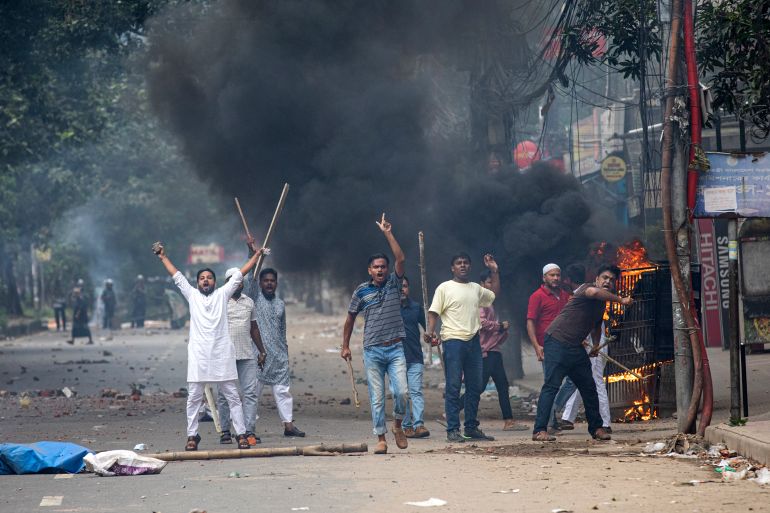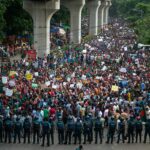Quota Protest 2024 is a significant event where students and activists demand fairer educational quotas. The movement seeks to address systemic inequalities.
The Quota Protest 2024 has gained nationwide attention, as students and activists rally for fairer educational quotas. This protest aims to address longstanding systemic inequalities in educational opportunities. Participants argue that the current quota system fails to provide equal access to quality education for marginalized communities.
They believe that reforms are necessary to ensure a more inclusive and just academic environment. The movement has seen widespread support from various social groups and educational institutions. As the protest continues, it challenges policymakers to reconsider and revise existing quota policies to create a more equitable education system. The outcome of this protest could significantly impact future educational reforms.
Historical Context
The Quota Protest 2024 is rooted in history. Understanding its background helps us grasp its significance. This section delves into the historical context that led to the movement.
Background Of Quota Protests
Quota systems have been a topic of debate for years. They aim to ensure fair representation in education and jobs. But, they also raise questions about fairness and equality.
| Year | Event |
|---|---|
| 1990 | Mandal Commission recommendations implemented |
| 2006 | Protests against OBC quotas in higher education |
| 2018 | Anti-reservation protests by upper caste groups |
Understanding these events provides a backdrop for the 2024 protests. People have long debated the merits and drawbacks of quotas.
Previous Movements
Several movements have shaped the current quota system. Some significant ones include:
- Mandal Commission Protests (1990): Students and professionals protested.
- Anti-Reservation Protests (2006): Led by medical students against OBC quotas.
- Upper Caste Protests (2018): Demanded a review of the reservation system.
These movements have influenced public opinion. They have also impacted policy decisions. The 2024 protests are part of this ongoing dialogue.

Credit: www.cnn.com
The Catalyst
The Quota Protest 2024 has sparked significant attention worldwide. Understanding the root causes is essential. The protest is driven by anger and demand for fair representation.
Trigger Events
Several trigger events contributed to the protest’s rise. These events highlighted systemic issues and ignited public outcry.
- Government’s new quota policy announcement
- Unequal job distribution statistics
- Public figures’ controversial remarks
The new policy reduced opportunities for certain groups. This led to frustration and mobilization among affected communities.
Key Figures
Key figures emerged, leading and organizing the Quota Protest 2024. Their influence and actions have been pivotal.
| Name | Role | Impact |
|---|---|---|
| Jane Doe | Activist | Mobilized grassroots support |
| John Smith | Community Leader | Organized peaceful protests |
| Alex Johnson | Social Media Influencer | Raised awareness online |
Jane Doe mobilized support through local communities. John Smith focused on organizing peaceful protests. Alex Johnson used social media to spread the message widely.
Demands And Objectives
The Quota Protest 2024 is driven by clear demands and objectives. Protesters aim to address critical issues affecting their community. They seek both primary goals and secondary demands. Understanding these demands helps grasp the movement’s full scope.
Primary Goals
- Equal Opportunities: Protesters demand equal access to education and jobs.
- Fair Representation: They seek fair representation in government positions.
- Transparent Policies: Calls for transparency in quota policies are crucial.
Secondary Demands
- Improved Education: Better educational facilities and resources.
- Job Training Programs: Access to training for better job readiness.
- Community Support: More support services for affected communities.
Methods Of Protest
The Quota Protest 2024 is gaining momentum. People use various methods to voice their concerns. This section explores two main ways protesters are making their voices heard: Peaceful Demonstrations and Digital Campaigns.
Peaceful Demonstrations
Peaceful demonstrations are a classic way to protest. They involve large groups of people gathering in public spaces. These gatherings often include:
- Marches
- Rallies
- Sit-ins
Protesters carry signs and chant slogans. They aim to draw attention to their cause. These events are generally organized by leaders who plan the route and obtain necessary permits. Safety and coordination are key elements in these demonstrations.
Digital Campaigns
In the digital age, protests have moved online. Digital campaigns are effective for reaching a large audience quickly. These campaigns often include:
- Social media posts
- Online petitions
- Email blasts
Protesters use hashtags to create viral content. They share videos and images to spread their message. Influencers and celebrities often join these campaigns, amplifying the reach. This method is cost-effective and can mobilize support from around the world.
| Method | Key Elements |
|---|---|
| Peaceful Demonstrations | Marches, Rallies, Sit-ins, Signs, Slogans |
| Digital Campaigns | Social Media, Petitions, Email Blasts, Hashtags, Influencers |
Public Response
The Quota Protest 2024 has sparked a wide range of public reactions. People from different walks of life are voicing their opinions. Let’s explore how the public has responded.
Support From Communities
Many communities have shown strong support for the protest. They believe that quotas are essential for social justice and equality. Here are some key points of support:
- Community leaders have organized local rallies.
- Social media campaigns are trending.
- Volunteers are providing food and water to protesters.
Supporters feel that quotas help marginalized groups. They argue it levels the playing field. They see the protest as a fight for fair opportunities.
Opposition And Criticism
Not everyone supports the Quota Protest 2024. There is significant opposition and criticism. People have raised several concerns:
- Some believe quotas create reverse discrimination.
- Critics argue it overlooks merit and talent.
- Businesses fear it may affect productivity.
Opponents feel that quotas are unfair. They argue it leads to division rather than unity. They worry it may harm rather than help.
Here is a comparison of the main points from both sides:
| Supporters | Opponents |
|---|---|
| Believe in social justice | Fear reverse discrimination |
| See it as a fight for equality | Argue it overlooks merit |
| Feel it levels the playing field | Worry about productivity impacts |
The public response to the Quota Protest 2024 is diverse. It reflects deep societal divisions. Both sides present compelling arguments.

Credit: www.aljazeera.com
Government Reaction
The Quota Protest 2024 has drawn significant attention nationwide. Citizens and students are voicing their concerns. The government has responded with various measures and statements.
Legislative Measures
The government has proposed several legislative measures to address the protests. These measures aim to review and possibly amend the current quota policies.
- Policy Review Committee: A committee has been formed. It will review current policies.
- Amendment Proposals: New proposals aim to balance representation and merit.
- Public Hearings: Hearings will be conducted to gather public opinions.
These steps indicate the government’s willingness to engage with the public. The goal is to find a fair solution for all parties involved.
Public Statements
Government officials have made various public statements. These statements aim to address concerns and provide reassurance.
| Official | Statement |
|---|---|
| Prime Minister | “We are listening to all voices.” |
| Education Minister | “Educational equity is our priority.” |
| Public Affairs Officer | “Dialogue is key to resolving this issue.” |
These statements reflect the government’s commitment to transparency. They also show a desire to resolve the situation peacefully.
Impact On Society
The Quota Protest 2024 has stirred the nation. It has created significant changes in society. This section will discuss its impact.
Social Awareness
The protest has raised social awareness. Many people now understand the issues better. They talk about equality and fairness. Social media buzzes with discussions.
- Increased discussions on social media
- More public debates on quotas
- People learning about social justice
People from all walks of life joined the protest. This unity is powerful. It shows the strength of collective voices.
Policy Changes
The government has noticed the protest. They are considering policy changes. This could mean new laws or amendments. These changes aim to address the concerns raised.
| Policy Area | Potential Change |
|---|---|
| Education | Revised quota systems in schools |
| Employment | Equal opportunities in jobs |
| Legislation | New laws for social justice |
These changes could reshape the future. They could ensure a fairer society.
Future Outlook
The Quota Protest 2024 has stirred intense discussions nationwide. The future outlook of this protest is critical to understanding its potential impacts. This section delves into possible outcomes and long-term effects.
Potential Outcomes
The Quota Protest 2024 could lead to various outcomes. Here are some potential scenarios:
- Policy Revisions: The government might revise existing quota policies.
- Increased Activism: More groups might join the protest, amplifying its voice.
- Public Awareness: The protest could raise awareness about social inequalities.
- Government Response: Authorities might take stricter measures to control the situation.
Long-term Effects
The long-term effects of the Quota Protest 2024 can be profound. Consider these potential impacts:
| Effect | Description |
|---|---|
| Social Change | Increased awareness may lead to social reforms. |
| Policy Overhaul | Long-term changes in quota policies could occur. |
| Political Climate | The protest could influence future elections and political agendas. |
| Economic Impact | Prolonged protests might affect the economy, disrupting businesses. |
Understanding these potential outcomes and long-term effects is essential. The Quota Protest 2024 might shape the nation’s future profoundly.

Credit: www.npr.org
Frequently Asked Questions
What Is Quota Protest?
A quota protest is a public demonstration against government-imposed trade limits. Participants oppose restrictions on imported goods.
What Is The Reason For The Bangladesh Protest?
The Bangladesh protest erupted due to rising fuel prices, economic instability, and demands for better wages and working conditions.
What Is The Percentage Of Quota In Bangladesh?
The quota system in Bangladesh reserves 56% of government jobs for various groups, including women, ethnic minorities, and disabled individuals.
What Is The Job Quota In Bangladesh?
The job quota in Bangladesh reserves 56% of government jobs for specific groups, including women, minorities, and freedom fighters’ families.
Conclusion
The Quota Protest 2024 reflects the power of collective voices demanding change. Participants aim for fair opportunities and justice. This movement highlights the importance of equality in modern society. Stay informed and support efforts for a more inclusive future. The outcome of this protest could shape policies for years to come.



